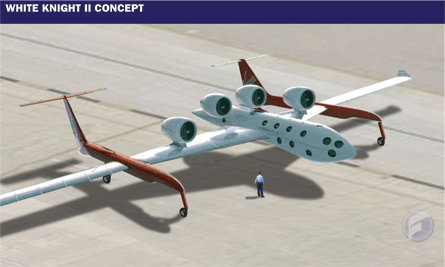The year ahead is set to either be a record breaker or will see major programmes unravel, with the European Space Agency, NASA, California based-Space Exploration Technologies (SpaceX) and UK space tourism company Virgin Galactic all facing key tests.
There are prizes to be won or lost:
- a successful start to the flight testing of the first suborbital tourism system's launch vehicle, White Knight II (WK2)
- demonstration of SpaceX's Falcon launchers using the company's new Merlin 1C engine
- the continued operation or retirement of Space Shuttle Atlantis
- the first delivery of International Space Station cargo by ESA's Jules Verne, the first of possibly six expendable automated transfer vehicles
- substantial contracts for Europe's stalled Galileo navigation programme
- transportation progress for Robert Bigelow's commercial space plans
- and preliminary design reviews for NASA's Constellation programme's Orion crew exploration and Ares I crew launch vehicles
Of these, the ATV, Virgin Galactic and Falcon have already been delayed from 2007 and it will not be long into 2008 before its known whether these programmes face more delays.

The first quarter is particularly busy, with: n the unveiling of Virgin Galactic's SpaceShipTwo and WK2 designs
- NASA's selection of its new Commercial Orbital Transportation Services demonstration programme phase one $175 million space act agreement company
- first launch of COTS participant SpaceX's Falcon 1 with the new Merlin 1C engine
- the March launch of ESA's second Galileo navigation programme test spacecraft Galileo In-Orbit Validation Element-B from Russia's Baikonur cosmodrome in Kazakhstan, and the maiden flight of the agency's Jules Verne from French space agency CNES' Kourou, French Guiana spaceport at about the same time.
Whether or not SpaceX's Falcon and ATV are pushed back into the second quarter, April to June will be no less interesting. By April it should be known if SpaceX has bought the majority share in UK robotic spacecraft manufacturer Surrey Satellite Technology that is now on offer. SpaceX already owns 10% of the company and on 6 December SSTL's chairman Sir Martin Sweeting remained tight-lipped over any new deal.
NASA expects to decide in April if it should retire Atlantis next September after its Hubble Space Telescope servicing mission and by then the full impact of having to work on a two-year old budget. NASA is currently being funded at 2006 levels because neither its requested fiscal year 2007 or FY2008, to date, have been approved. If the FY2008 budget is not approved soon, the agency's administrator Michael Griffin has warned of further delays to his Orion's initial operating capability date of March 2015.
In a 10 December press conference on NASA's progress with the Constellation programme, manager Jeffrey Hanley described 2008 as the year of PDRs. According to the agency's 19 October 2007 Multi-Program Integrated Milestones schedule, from April to August Hanley's project offices will be carrying out PDRs for the CLV and Orion and also a critical design review for the Ares I's upper stage engine, the J-2X. By the start of the third quarter it will become apparent what impact NASA's budgetary problems have had on its ability to close out those reviews.
Mid-year progress
By mid-year it is possible there will be progress for Bigelow Aerospace and its Galaxy class inflatable spacecraft iron bird and its habitable Sundancer model, which the company plans to launch in 2010. More uncertain is the possiblity of any progress with Bigelow's offer of $760 million for a transportation system to reach its proposed orbital complexes.
About the same time, ESA expects to place contracts for the Galileo navigation programme's 30 satellites that will fly in medium Earth orbit. And in the third quarter New Mexico's Spaceport America could gets its spaceport licence from the US Federal Aviation Administration, probably by September.
The fourth quarter is set to be no less exciting and will see an ESA ministerial meeting that could give the green light to development of a joint western European-Russian manned spacecraft the first COTS demonstration launch of SpaceX's Falcon 9 rocket and its Dragon capsule and perhaps even a Chinese spacewalk.
Finally, the US presidential elections will see a new leader elected in November. Of the two Democratic party candidates that have been clear about their space policies so far, Barack Obama wants to divert NASA funds to education while Hillary Clinton supports Constellation. Whoever resides in the White House come January 2009 their decisions for COTS, Constellation and Shuttle could be the most testing time of all.
Source: Flight International








































